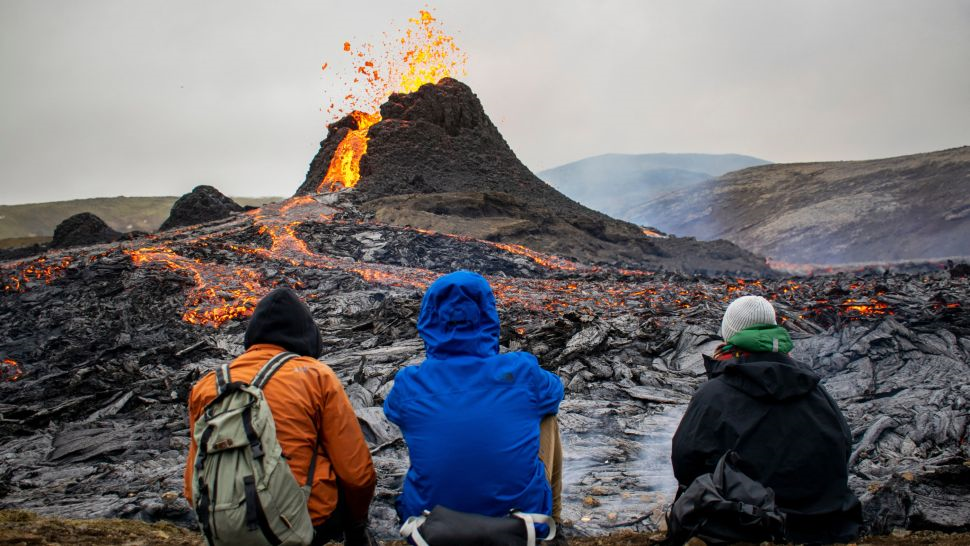O OVGA é um Centro de Ciência que desenvolve atividade de investigação aplicada e de divulgação científica na área da Vulcanologia, da Sismologia e da Geotermia.
Notícia -A A +A
Drone footage reveals dramatic Iceland volcanic eruption
Notícia OVGA 24-03-2021
The country has been rocked by over 50,000 earthquakes in the past three weeks of build up to the recent eruption.

Ash plume from Iceland's Eyjafjallajökull crater during the 2010 eruption, ejecting fine ash high into the atmosphere and resulting in the temporary closure of airspace due to the danger posed to airplanes and onboard passengers (Image: Etienne De Malglaive/Getty Image)
After a 900-year nap, a volcano in Iceland erupted Friday (March 19), spewing tendrils of molten lava down its flanks and bathing the cloudy night sky in an ominous orange-red.
Gorgeous and fiery photos show the Fagradalsfjall volcano, located about 25 miles (40 kilometers) southwest of Reykjavik near the Reykjanes Peninsula, with streams of orange-red lava flowing out of a fissure at its top. One daring visitor flew a drone just above the glowing lava river and the vent of the erupting volcano.
The eruption comes after three weeks of intensifying seismic activity in the area, over which the island nation recorded more than 50,000 earthquakes. The volcano began spouting lava Friday at around 4:45 p.m. ET (8:45 p.m. local time) and continued throughout the weekend
A helicopter flies over the eruption. (Image credit: Vilhelm Gunnarsson via Getty Images)
"It's absolutely breathtaking," Ulvar Kari Johannsson, a 21-year-old engineer, told the AFP news agency. "It smells pretty bad. For me, what was surprising was the colors of the orange: much, much deeper than what one would expect."
"The eruption is considered small at this stage and the volcanic activity has somewhat decreased since yesterday evening," the Icelandic Meteorological Office (IMO) said in a statement. The fissure the lava is spewing from is roughly 1,640 to 2,300 feet (500 to 700 meters) wide, according to the IMO.
Although Iceland's Keflavik International Airport and the fishing town of Grindavik are just a few miles away from the eruption site, the lava flows aren't expected to pose any danger. That's because volcanic eruptions in the region are so-called effusive eruptions, where lava seeps out of the ground at a steady rate rather than building up and exploding outward as Iceland's Eyjafjallajökull volcano did in 2010. Eyjafjallajökull released ash clouds high into the atmosphere, halting European air traffic for weeks until the ash had settled.
The biggest threat these types of eruptions can pose is from the gases they emit — notably, sulfur dioxide, which can be fatal in large enough doses. Although the IMO reported Saturday that it does not expect the pollution of this particular eruption to have detrimental health effects, the Met office has warned nearby residents to keep their windows closed.
"Currently, gas pollution is not expected to cause much discomfort for people except close up to the source of the eruption," the IMO said. "The gas emissions will be monitored closely."
Iceland is known for its volcanic activity, with 32 active volcanic systems; that's because the island sits atop the mid-Atlantic ridge, which formed as a result of a giant crack on the ocean floor between which the North American and Eurasian plates slide against each other as they move in opposite directions.
It's this motion that can cause earthquakes and enormous flows of molten rock, known as magma, to rise rapidly toward the surface. The erupting material that pushes through that crack also forms the ridge itself.
Source: Volcano Discovery, March 232021
Adenda OVGA: Drone Video in link below
https://www.livescience.com/drone-footage-reveals-dramatic-iceland-volcanic-eruption.html

